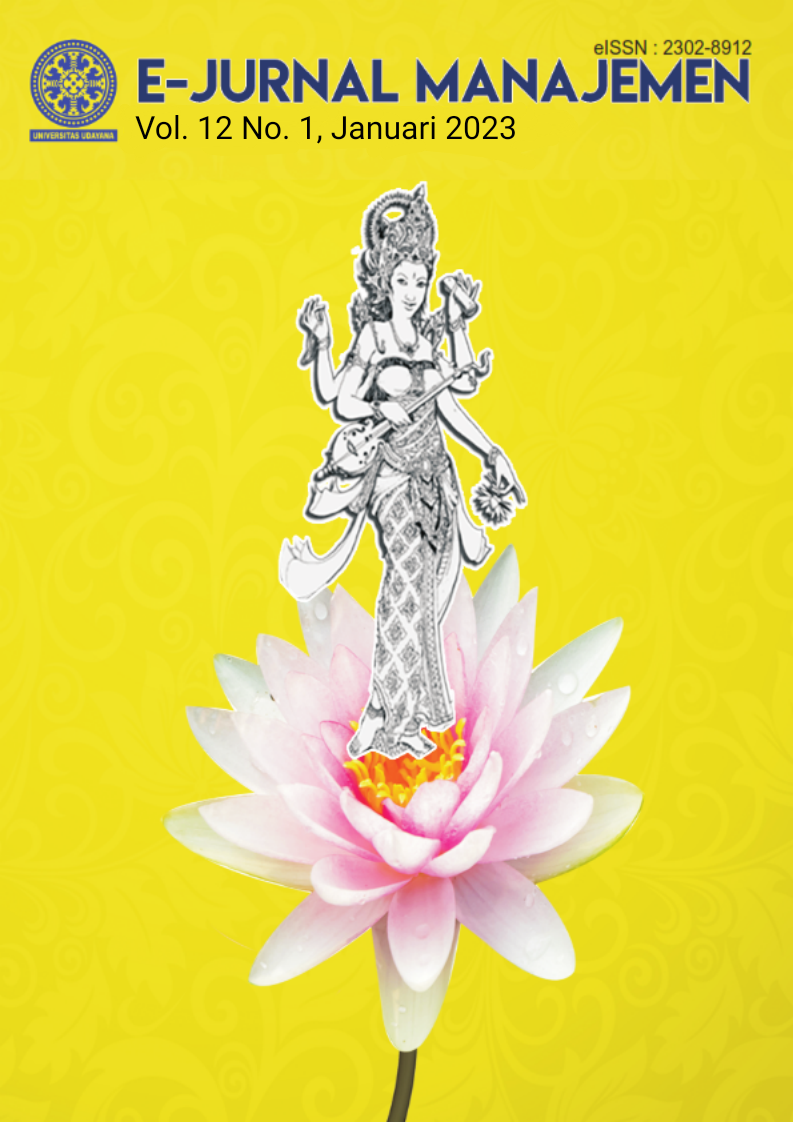PENGARUH KARAKTERISTIK PRIBADI PADA LOYALITAS MENGGUNAKAN E-COMMERCE GENERASI X DAN GENERASI Y
Abstract
Penelitian ini memiliki tujuan untuk menguji pengaruh kesesuaian dan persepsi inovasi yang merupakan karakteristik pribadi terhadap kemudahan penggunaan dan manfaat yang nantinya akan berpengaruh terhadap loyalitas penggunaan e-commerce pada generasi X dan generasi Y. Penelitian ini menggunakan data sebanyak 217 responden dengan metode purposive sampling, yang dikumpulkan menggunakan kuisioner dari google form yang dibagikan melalui media sosial dan whatsapp serta dianalisis menggunakan regresi serderhana dan berganda dengan bantuan SPSS. Hasil yang diperoleh dari penelitian ini mengungkapkan bahwa kesesuaian dan persepsi inovasi berpengaruh secara positif terhadap manfaat. manfaat memiliki pengaruh yang signifikan pada loyalitas.
This study aims to examine the effect of conformity and perceived innovation which is a personal characteristic on ease of use and benefits which will later affect the loyalty of using e-commerce in generation X and generation Y. This study used data of 217 respondents with purposive sampling method, which collected using questionnaires from google forms distributed through social media and whatsapp and analyzed using simple and multiple regression with the help of SPSS. The results obtained from this study revealed that conformity and perceived innovation influence positively to benefits. benefits have a significant effect on loyalty. In generation X and generation Y, there is a difference in the effect between conformity and perceived innovation. There is no difference in the effect of conformity, perceived innovation and subjective norms on the benefits of generation X and generation Y. And there is no difference in the effect of ease of use and benefits on loyalty from generation X and generation Y.
Downloads
References
Agarwal, R., & Karahanna, E. (1998). On the multi-dimensional nature ofcompatibility beliefs in technology acceptance. In: Proceedings of the 19th Annual International Conference on Information Systems, 1(1), 13–16.
Bougie, R., & Sekaran, U. (2010). Research Methods For Business(5th ed.). John Wiley and Sons Ltd.
BrandAmplitude. (2009). The Millennial Handbook: a snapshot guide to everything Gen Y. www. Brandamplitude .com/ The _ Millennial_Handbook.pdf
Chen, C.-Y., Rong, J., Hsu, C., Chen, C.-W., Chen, H.-H., Kuo, C.-F., & Cheng, M.-H. (2007). Generation of internal solitary wave by gravity collapse. Journal of Marine Science and Technology, 15(1), 1-7.
Cooper, & Schindler. (2014). Bussiners Research Method. New York: McGraw-. Hill.
Crumpacker, M., & Crumpacker, J. (2007). Succession Planning and Generational Stereotypes: Should HR Consider Age-Based Values and Attitudes a Relevant Factor or a Passing Fad? Public Personnel Management, 36(4), 349–369.
Eastman, J., Iyer, R., & Thomas, S. (2013). The impact of status consumption on shopping styles: an exploratory look at the millennials generation. Journal Marketing Management, 23(3), 57–73.
Eisner, S. P. (2005). Managing Generation Y. S.A.M Advanced Management Journal, 70(4), 4-15.
Gardiner, S., Grace, D., & King, C. (2015). Is the Australian domestic holiday a thing of the past? Understanding baby boomer, Generation X and Generation Y perceptions and attitude to domestic and international holidays. Journal of Vacation Marketing, 21(4), 336–350.
Gillenson, M. L., Chen, L., & Sherrell, D. L. (2002). Enticing online consumers: an extended technology acceptance perspective. Information Management, 39(8), 705–719.
Gurau, C. (2012). A life‐stage analysis of consumer loyalty profile: comparing Generation X and Millennial consumers. Journal of Consumer Marketing, 29(2), 103–113. https://doi.org/https://doi.org/10.1108/07363761211206357
Gursoy, D., Maier, T. A., & Chi, C. G. (2008). Generational differences: An examination of work values and generational gaps in the hospitality workforce. International Journal of Hospitality Management, 27(3), 448–458.
Hartono, J. (2016). Teori Portofolio dan Analisis Investasi(10th ed.). Yogyakarta : BPFE.
Jin, L., & Robey, D. (1999). Explaining cyber meditation: an organisational analysis of electronic retailing. International Journal Electronic Commerce, 3(4), 47–66.
Lewis, W., Agarwal, R., & Sambamurthy, V. (2003). Sources of influence on beliefs about information technology use: an empirical study of knowledge workers. MIS Quarterly: Management Information Systems, 1(2), 657-678.
Lissitsa, S., & Kol, O. (2016). Generation X vs Generation Y –A decade of online shopping. Journal Retail Consumer Services, 31(1), 304–312.
Lu, J., Yao, J. E., & Yu., C. S. (2005). Personal innovativeness, social influences and adoption of wireless Internet services via mobile technology. Journal Strategic Information System, 14(3), 245–268.
Malhotra, N., Sahadev, S., & Purani, K. (2017). Psychological contract violation and customer intention to reuse online retailers: Exploring mediating and moderating mechanisms. Journal of Business Research, Elsevier, 75(3), 17-28.
Myers, K. ., & Sadaghiani, K. (2010). Millennials in the Workplace: A Communication Perspective on Millennials’ Organizational Relationships and Performance. Journal of Business and Psychology., 1(1), 1–12.
Nusair, K., Bilgihan, A., Okumus, F., & Cobanoglu, C. (2013). Generation Y travelers’ commitment to online social network websites. Tourism Management, 35(3), 1–12.
Oghuma, A. P., Libaque-Saenz, C. F., Wong, S., & Chang, Y. (2016). An Expectation-Confirmation Model of Continuance Intention to Use Mobile Instant Messaging. Telematics and Informatics, 33(1), 34-47.
Otero, E. L., Muñoz Gallego, P. A., & Pratt, R. M. E. (2014). Click-and-Mortar SMEs: Attracting customers to your website. Business Horizons, Elsevier, 57(6), 1–10.
Ozturk, A. B., Bilgihan, A., Nusair, K., & Okumusa, F. (2016). What keeps the mobile hotel booking users loyal? Investigating the roles of self-efficacy, compatibility, perceived ease of use, and perceived convenience. International Journal of Information Management, 36(6), 1350–1359. https://doi.org/https://doi.org/10.1016/j.ijinfomgt.2016.04.005
Purani, K., Kumar, D., & Sahadev, S. (2019). e-Loyalty among millennials: Personal characteristics and social influences. Journal of Retailing and Consumer Services, 48(1), 215–223. https://doi.org/https://doi.org/10.1016/j.jretconser.2019.02.006Rambocas, M., & Arjoon, S. (2012). Using diffusion of innovation theory to model customer loyalty for Internet banking: a TT millennials perspective. International Journal Business Commer, 1(8), 1-14.
Shankar, V., Venkatesh, A., Hofacker, C., & Naik, P. . (2010). Mobile Marketing in the Retailing Environment: Current Insights and Future Research Avenues. Journal of Interactive Marketing, 24(2), 111–120. https://doi.org/https://doi.org/10.1016/j.intmar.2010.02.006
Turan, A., Tunç, A. ., & Zehir, C. (2015). A Theoretical Model Proposal: Personal Innovativeness and User Involvement as Antecedents of Unified Theory of Acceptance and Use of Technology. Procedia -Social and Behavioral Sciences, 210(2), 43–51.
Veloutsou, C., & McAlonan, A. (2012). Loyalty and or disloyalty to a search engine: the case of young Millennials. Journal of Consumer Marketing, 29(2), 125-135. https://doi.org/https://doi.org/10.1108/07363761211206375
Wu, I.-L., Lu, C.-C., & Hsiao, W.-H. (2019). Developing Customer Product Loyalty through Mobile Advertising: Affective and Cognitive Perspectives. International Journal of Information Management, 47(1), 101–111.





















